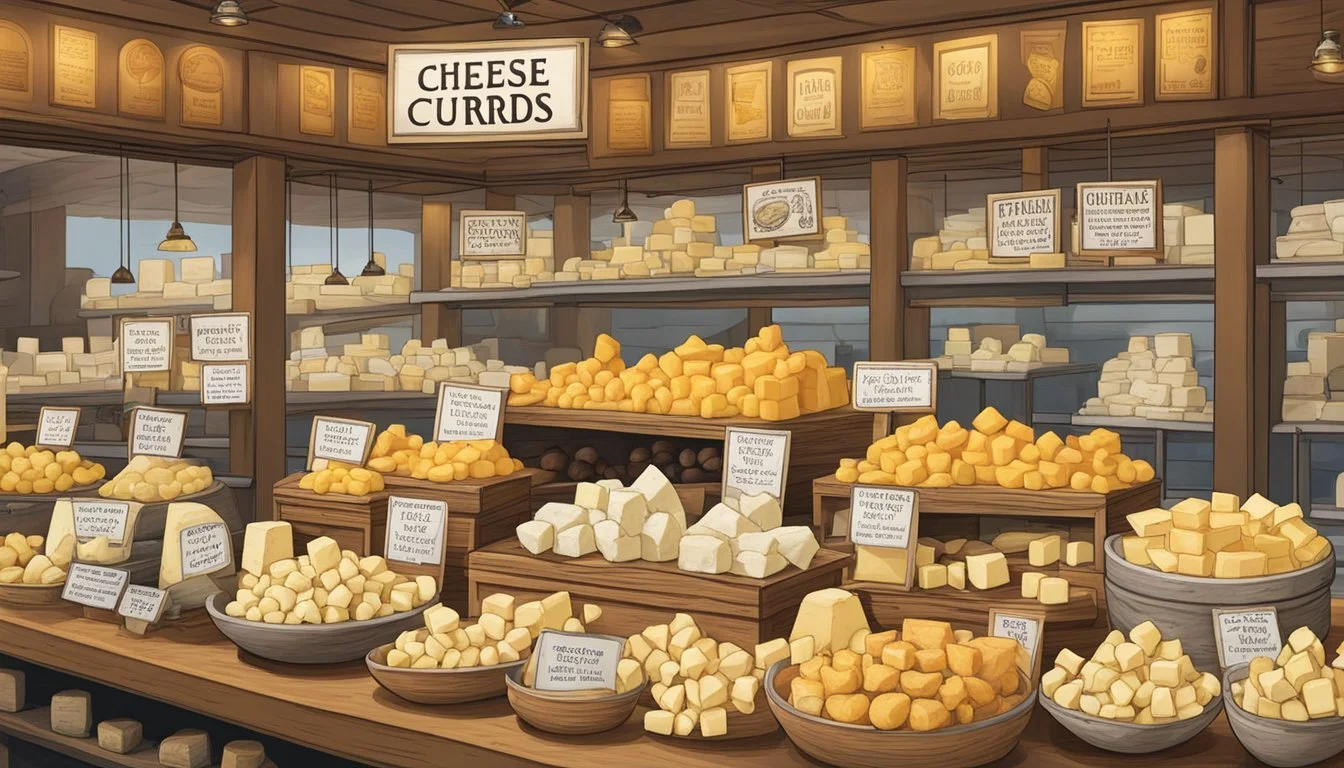How Long Do Cheese Curds Last?
Storage Tips and Shelf Life
Cheese curds, a beloved snack made from fresh milk, are particularly famous in regions like Wisconsin, known for their cheese production. These bite-sized nuggets are cherished for their squeaky texture and fresh flavor. When properly refrigerated and stored in an airtight container, cheese curds can last for up to two weeks.
Cheese curds are at their best when enjoyed shortly after purchase to savor their unique texture and taste. While they can be frozen to extend their lifespan, freezing can alter their squeak and flavor. It's important to consume them within a few days for the optimal experience.
For those who revel in the deliciousness of cheese curds, understanding their shelf life is key. Whether you're enjoying them as a snack or incorporating them into recipes, knowing how long they last ensures you get the most out of their fresh, delightful flavor.
Understanding Cheese Curds
Cheese curds are small chunks of curdled milk known for their unique texture and flavor. They come in various types, including fresh and aged, each offering a distinct taste and experience.
What Are Cheese Curds
Cheese curds are a dairy product made during the process of producing cheese, most commonly cheddar. When the milk coagulates, it separates into curds and whey. The curds are then cut and cooked until they reach the desired texture.
These curds are fresh and semi-solid. The most common varieties are plain or flavored, with seasonings like garlic or dill added. Cheese curds are a popular snack in regions known for cheese production, especially places like Wisconsin.
Texture and Flavor Analysis
Cheese curds are famed for their distinctive texture. Fresh cheese curds possess a squeaky quality when bitten into due to the high moisture content and elasticity. This squeakiness is often described as rubbery, adding to their unique mouthfeel.
Flavor-wise, cheese curds have a mild, milky taste with a hint of saltiness. Fresh curds offer a light, creamy flavor, while aged ones may develop a more pronounced, complex profile. Flavored cheese curds incorporate various seasonings, enhancing the taste further without losing the characteristic texture.
Fresh vs. Aged Cheese Curds
Fresh cheese curds are best enjoyed within the first few days after production to experience their characteristic squeakiness. They are typically not aged, maintaining their soft, elastic texture.
Aged cheese curds, on the other hand, lose their squeak over time due to moisture loss and protein changes. They may become firmer, resembling regular cheese more than fresh curds. While fresh curds are preferred for their unique texture, aged ones can be used in various culinary applications where a firmer consistency is desired.
Freshness and Squeakiness
Fresh cheese curds are often enjoyed for their unique texture and taste. Their desirable qualities are influenced by a range of factors including protein content, moisture levels, and storage conditions.
Importance of Squeakiness
Squeakiness is a hallmark of fresh cheese curds. This squeak comes from the elasticity of the protein, particularly when curds are fresh and contain ample moisture.
The squeak is produced when the proteins rub against the enamel of the teeth. The calcium in cheese curds also contributes to their firm texture, enhancing the squeakiness. Thus, squeakiness is a reliable indicator of freshness and quality.
Factors Affecting Freshness
Several factors influence the freshness of cheese curds, including temperature and storage conditions. Cheese curds can typically last between one to two weeks when refrigerated properly.
Exposure to air can cause curds to dry out, which reduces moisture and diminishes their squeak. Flavored cheese curds follow the same storage guidelines as plain curds to maintain their quality.
Refrigeration slows bacterial growth and helps maintain protein integrity. Unrefrigerated curds should be consumed within 4 hours to preserve their fresh taste and squeakiness. Proper handling and storage are crucial for extending the freshness of cheese curds.
Storage Fundamentals
Proper storage is crucial for maintaining the freshness and squeakiness of cheese curds. Key factors include optimal refrigeration techniques and suitable methods for freezing cheese curds.
Optimal Refrigeration Techniques
To keep cheese curds fresh, storing them in the refrigerator is essential. Ideally, the temperature should range between 34°F to 40°F (1°C to 4°C). An airtight container is recommended to prevent exposure to moisture and odors.
Refrigeration slows bacterial growth, preserving the curds' quality for up to two weeks. It's critical to check the temperature settings regularly and ensure the fridge remains at the optimal range.
Freezing Cheese Curds
For extended storage, freezing cheese curds is a viable option. Place curds in an airtight container or freezer-safe bag to protect them from moisture and freezer burn. Properly sealed curds can last several months in the freezer.
When ready to use, thaw them in the refrigerator overnight. Avoid thawing at room temperature to maintain their texture and prevent bacterial growth. Proper thawing preserves the curds' unique squeaky quality.
Shelf Life and Preservation
Cheese curds are a delightful dairy product, but their shelf life depends significantly on storage methods. Proper storage can extend the curds' freshness while improper handling may lead to quicker spoilage.
Determining Shelf Life
Cheese curds generally last 1 to 2 weeks when stored in the refrigerator at temperatures between 34°F and 38°F (1°C and 3°C). The freshness at the time of purchase and moisture content influence this period.
Unrefrigerated cheese curds have a much shorter shelf life. At room temperature, they can last up to 24 hours. After this time, their texture and flavor often degrade. Packaging also plays a crucial role, with vacuum-sealed packaging extending their life by maintaining freshness and preventing contamination.
Extending Cheese Curds' Freshness
To prolong the freshness of cheese curds, refrigeration is essential. Keep them in an airtight container to minimize exposure to air, which can dry them out. Vacuum-sealing is especially beneficial as it reduces oxygen exposure and maintains moisture content.
For longer preservation, freezing is effective. When frozen properly, cheese curds can last up to several months. It's recommended to use a vacuum-sealed package before freezing to maintain the best quality. Defrost frozen curds gradually in the refrigerator to retain texture and flavor.
Signs of Spoilage
Spoiled cheese curds can be identified through visual, olfactory, and textural changes. Recognizing these signs ensures food safety and maximizes enjoyment.
Visual and Olfactory Indicators
Spoiled cheese curds often exhibit discoloration. They may turn yellow or develop green, blue, or black patches, indicating mold growth. This mold is a clear sign that the cheese curds are no longer safe to consume.
Off smells are another indicator. Fresh cheese curds have a mild and pleasant dairy aroma. If they emit a strong, unpleasant, or sour odor, it signals spoilage.
Moldy appearance combined with off smells should prompt immediate disposal to avoid health risks associated with spoiled dairy products.
Texture Changes and Implications
A significant textural change in cheese curds is the development of a slimy texture. Fresh cheese curds have a firm yet squeaky feel. When they turn slimy, it’s a sign that bacteria have started to spoil the curds.
They might also feel excessively hard or brittle, contrasting with their original texture. This change indicates that the quality and freshness have degraded.
Eating cheese curds with these textural changes can be unpleasant and risky. Recognizing a slimy feel or unusual hardness helps in identifying curds that should be discarded for safety.
Impact of Temperature
The shelf life and quality of cheese curds can significantly depend on the surrounding temperature. Proper storage is essential to maintain their freshness and signature squeakiness.
Room Temperature vs. Refrigeration
Cheese curds left at room temperature typically spoil within a few hours.
Stored properly in the refrigerator, they can last up to two weeks. Room temperature accelerates spoilage and can quickly degrade their texture and flavor.
Refrigeration slows down these processes. Optimal refrigeration temperatures range from 34°F to 38°F (1°C to 3°C). Storage in an airtight container also helps preserve their quality.
Thawing and Melting Considerations
Freezing cheese curds can extend their shelf life.
Thawing must be done gradually in the refrigerator to prevent texture loss. Rapid thawing or microwave use are discouraged as they can lead to uneven melting.
Melting cheese curds at low, steady temperatures maintains consistency. High heat can cause them to become oily or grainy.
Freezer storage can keep cheese curds edible for up to six months, though some textural compromises may occur.
Health and Safety Concerns
Proper storage and handling of cheese curds are critical to prevent foodborne illnesses and ensure safe consumption. Below are essential guidelines to avoid health risks associated with cheese curds.
Avoiding Foodborne Illnesses
Cheese curds are perishable, making them susceptible to bacterial growth. Bacteria such as Listeria monocytogenes, Salmonella, and E. coli can develop if curds are not stored correctly.
To prevent spoilage and bacterial contamination:
Store cheese curds in an airtight container.
Keep the storage temperature at or below 40°F (4°C).
Monitor the expiration date and consume within one to two weeks.
Inspect curds before consumption for any unusual odors, discoloration, or texture changes. Discard any curds that appear spoiled.
Safe Handling and Consumption
Proper handling starts at the point of purchase and continues through preparation and serving. Always:
Wash hands thoroughly before and after handling cheese curds.
Use clean utensils and surfaces to avoid cross-contamination.
If left out, make sure curds do not stay at room temperature for more than two hours.
Ensure to refrigerate promptly after use and follow best practices for food safety. Additionally, freezing cheese curds can extend their shelf life but may affect texture. If freezing, use them within two months for best quality.
Regularly check labels and follow all storage instructions provided by manufacturers to minimize health risks.
Innovative Uses for Cheese Curds
Cheese curds are a versatile ingredient that can elevate a variety of dishes. They can be used in everything from classic recipes to modern culinary delights, and they pair beautifully with many other foods.
Classic and Modern Recipes
Cheese curds shine in both traditional and contemporary recipes.
Poutine is a beloved classic, featuring cheese curds, french fries, and rich gravy. Another popular option is fried cheese curds, which are often breaded and deep-fried to crispy perfection.
These curds can also enhance omelets, adding a burst of cheesy flavor. Modern takes on cheese curds include incorporating them into salads and using them as a unique pizza topping. They add a delightful texture and a creamy taste to many dishes.
Pairing with Other Foods
Pairing cheese curds with other foods can create a memorable eating experience.
They work wonderfully in sandwiches for an extra layer of flavor and texture. Cheese curds can also be served with crackers and fruit, making for an excellent snack or appetizer.
For a sophisticated touch, pair them with wine. White wines like Chardonnay and red wines such as Pinot Noir complement the creamy texture and tangy taste of the curds.
These pairings make cheese curds a versatile addition to any meal.
The Cultural Significance of Cheese Curds
Cheese curds have a rich history and have infiltrated various culinary traditions, particularly in regions known for dairy production. This importance is evident in their widespread popularity in regional dishes.
Popularity in Culinary Traditions
Cheese curds, often known for their fresh, squeaky texture, hold a special place in dairy-centric regions. Their origins trace back to Wisconsin, where local dairy farmers produce them in abundance. At farmers’ markets and grocery stores, these curds quickly become a cherished snack due to their unique texture and fresh taste.
These cheese pieces are not just consumed as snacks. They feature prominently in dishes like poutine, a Canadian staple that combines fries, gravy, and cheese curds, exemplifying the curds' importance in various culinary cultures.
Cheese Curds in Regional Cuisines
In Wisconsin, cheese curds are cherished not just for their flavor but also for their role in local traditions. Enjoyed fresh, deep-fried, or melted, they are a versatile ingredient found at county fairs and local eateries. Their tangy flavor and distinct texture make them a beloved addition to numerous regional dishes.
Beyond Wisconsin, cheese curds have gained popularity in various parts of North America. Recognized in Canadian cuisine, especially in poutine, they bridge cultural food practices across borders, highlighting their universal appeal. At farmers’ markets and modern food festivals, they stand as a testament to their widespread appreciation.











